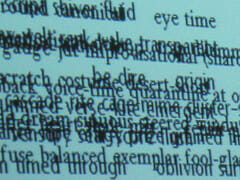 I’ve been talking off and on for the last few months about the eventual demise of the book as the primary conveyer of what we probably should start calling “text.”
I’ve been talking off and on for the last few months about the eventual demise of the book as the primary conveyer of what we probably should start calling “text.”
When E.M. Ginger said that we probably haven’t seen a book on an e-Reader, and we may never see one, I had to agree.
I don’t look at the advance of technology as either a good thing or a bad thing. It is an inevitable thing, and it seems smart to try to see where the change is going. Printed books have advantages and disadvantages as “text delivery systems” just as e-Books do. (I would start calling them “e-Texts,” but I don’t need another hopeless battle in my life at the moment.)
The Godfather Weighs In
Dan Poynter, author of the Self-Publishing Manual, and a self-avowed “godfather” to thousands of self-publishers (me included) sees the change coming, and he’s enthusiastic. Dan likes the idea of cutting all those pesky costs, and becoming purveyors of pure “information products.”
But what are we to make of the statement at a Digital Book World presentation Dan did with Mark Coker of Smashwords, that e-Books:
liberate text from complex formatting and layout.
Or that one of the reasons e-Books are superior to print books is that they are less expensive to produce, since you have “no typesetting.” They point to all the “free” file converters that will process your plain vanilla MS Word file and spray it into a variety of digital formats.
Yes, text is freeing itself from many old constraints. It was while these thoughts were swirling in my mind this morning that I picked up today’s New York Times to find a small item under “Media Talk” by Motoko Rich titled Kindle Books in Snack Sizes.
We Could Call Them McBooks, But We Won’t
As it turns out,
FT Press has introduced two series of short, digital-only titles for professionals who want quick snippets of advice for $2.99 or less . . . through the Kindle booksotre on Amazon.com and Barnes & Noble’s e-bookstore.
These are 1,000 to 5,000 word versions of books that have already been published. (A typical business book is about 50,000 – 70,000 words). 242 titles are already in print, with plans to hit 500 by the end of the year. The item goes on to say that demand for longer books has fallen because people only want to “access” pieces of books, not the whole thing.
Here’s my favoite quote from this article, from Seth Goldman, who runs Honest Tea, a maker of organic teas, and is also the author of one of the books “shortened” for sale in this new format:
“There is size and substance to it, but it’s not a full meal,” Mr. Goldman said. “It’s a healthy lunch on the go as opposed to the seven-course meal”
What Does It All Mean?
Text is being liberated, while we reduce books to 1,000 words of healthy McBites. Once the book ceases to be a book—an arrangement of sequential pages on sheets bound together to form a whole—it becomes simply text, to be processed, lengthened, shortened, adjusted to fit the user’s needs. Who are we, after all, to say you shouldn’t read War and Peace in Verdana, as you’ll be able to do on the iPad?
A book is something fixed for a time: a text, in a physical container, expressed through the typography used to embody it. An e-book has none of these properties, and that’s why it isn’t really a book.
But beyond labels and semantics, the book is the ultimately long-text delivery system, honed to near perfection by 500 years of experiment and refinement.
But wait, there’s another slide in the Poynter/Coker presentation that tells more of the story.
Winners and Losers? Who’s Counting?
This slide is called “Winners and Losers in the new ebook supply chain” and it includes in the winners “Publishers, Authors, Readers, ebook Retailers and ebook Hardware Makers.” Sounding pretty good, yes?
Who are the “Losers”? “Tree growers, tree pulpers, ink, glue, printing press makers, Printers, remainderers, slow-to-adapt Print Publishers, Print Bookstores.”
Okay, so the way they’ve set it up, we have on one side, authors, readers and publishers. Against them are pitted the tree pulpers, glue makers, and the slow-to-adapt crowd. That’s a pretty slanted, but damning, picture. But notice that there are no typographers on this list, no editors, no cover designers, no layout artists, no indexers, no proofreaders. I wonder if they are winners or losers?
Here We Go
You’ve probably figured out that I don’t know where this is leading any more than you do. Text has been liberated, but the book is in a slow-motion death spiral. It will last a long time, but not forever. Here are the questions I ask myself:
- How long will it be before the economic pressure alone makes e-books the preferred—the dominant—form for publishing new works?
- Will a format be developed before then that allows book designers and typographers to influence the way these “texts” look on screen in a reliable, predictable way?
- What will be the long-term effect of moving from a culture founded on literacy, education, history and philosophy all communicated by books, to a culture that “accesses” pieces of free-floating text?
- How many institutions built around the book—libraries, book stores, publishing houses—will be either transformed or eliminated by the move to text and e-books?
What do you think?


